|
What is the best style of
acupuncture?
There are many styles of acupuncture – Traditional Chinese Acupuncture,
Japanese Acupuncture, 5-element acupuncture, Distal Needling, etc.
Some acupuncturists will try to convince you that their style is
superior to every other style, some going to the extent of
telling you that other styles simply don’t work (and they may truly believe
this), but they don’t understand the other styles well enough to give an
accurate comparison of strengths and weaknesses.
Different styles appeal to different practitioners, so of
course they are going to be
better at the style that they make an effort to learn well because it
appeals to them. As part
of my education I received training and clinicals in Japanese acupuncture,
5-element acupuncture, and Distal Needle acupuncture, but the combination of
styles I now practice were the ones that appealed to me the most, and
therefore became the most effective styles for me.
I practice Traditional Chinese Medicine/Acupuncture,
with a history of over 5000 years.
For treating pain,
I use trigger point referral
patterns (mapped out by John F. Kennedy’s Whitehouse Physician Dr. Janet
Travell), and treat the underlying conditions that cause pain with
Traditional Chinese Acupuncture and herbs. Needling
trigger points is now being called "Dry Needling" by Physical
Therapists, though their technique protocol which is most often practiced
uses a lot of needle manipulation and is painful, as opposed to my pain-free
technique of inserting and leaving needles in place rather than aggressively
manipulating them.
Trigger
points are a
symptom, not a
cause. Needling or applying pressure to
the trigger points treats the acute part of the problem, but does not solve
the underlying factors. If you get temporary relief from pain but symptoms
quickly recur, then trigger points are definitely a factor, but perpetuating
factors need to be addressed in order to gain more lasting relief. Trigger
points may form after a sudden trauma or injury, or they may develop
gradually. Common initiating and
perpetuating factors are mechanical
stresses, injuries, nutritional problems, emotional factors, sleep problems,
acute or chronic infections, organ dysfunction and disease, and other
medical conditions. To get long-term relief from trigger points, you need
to eliminate the perpetuating factors that cause and keep trigger points
activated.
I have my patients fill out a complete medical history and spend on average
at least 45 minutes discussing the medical history
before reaching a preliminary
diagnosis and treatment plan, then do an exam and treatment, and then spend another half hour before the
next appointment reviewing and refining my diagnosis and treatment plan.
At the beginning of each subsequent appointment I ask how you
responded to the last treatment, and get any new information.
Together we can do the detective work and get to the source of the
problem, and I will provide you with literature, advice, and training that
includes information on perpetuating factors and how to resolve them,
self-help techniques, and dietary advice, in order to get lasting relief.
But pain is only one condition that Traditional
Chinese Medicine/Acupuncture treats.
For a list of conditions see
http://triggerpointrelief.com/Clinics/AcupunctureConditionsTreated.html.
During the preliminary phone conversation I will give you an honest
assessment of whether I think I’ll be able to help you, or I'll tell you if I’m
not sure, and that we’ll just need to see how you respond to
treatment.
I won’t ever tell you
something I think you want to hear just to get you into my clinic (including
that my style is superior to another practitioner’s, or that I can treat a
condition that I can't or shouldn't treat with acupuncture), or attempt to
get you to schedule with me instead of or in addition to, if you have
already booked with another acupuncturist (I feel this practice is
unethical, and that you should only see one acupuncturist at a time, since
it then confounds the results).
If you aren’t getting the results I expect you to have, I will refer
you out for imaging and/or lab work for additional information.
I won’t keep treating a patient I’m not helping, and will make every
effort to connect you with a Health Care Provider who may be able to help
you. I estimate I have about a
98% rate of effectiveness.
How
does acupuncture work?
The answer is: No one knows for sure. The ancient Chinese theory is
that there are meridians throughout the body where "Qi", or energy, flows.
If there is a block in the meridian, disease and pain result. By
inserting an acupuncture needle in the blocked point, the flow of Qi, and
therefore health, is restored.
Western medicine is just beginning to substantiate that indeed, acupuncture
does have effects that cannot be explained by what we currently know about
human physiology. When performing a "functional MRI" and needling
points in the foot known to affect the eyes, the MRI shows activity in the
visual part of the cortex of the brain. Many people believe
acupuncture is a biochemical process -- needling affects the nerve synapses,
and therefore the neurotransmitters that transmit information to the brain.
Acupuncture points can be found by measuring the electrical resistance on
the skin.
Even though we can't yet entirely explain exactly how acupuncture works,
5000 years of needling acupuncture points has resulted in a vast body of
knowledge regarding the effects from needling each of the over 400
acupuncture points.
The first visit includes a comprehensive medical history interview and a
full treatment, which takes about 1.5 hours. All of your symptoms are
discussed, even those you may think are unrelated. I then develop a
preliminary Chinese Medicine Diagnosis, which determines
acupuncture point selection. Before your second appointment, I go
through your medical history and develop a more detailed diagnosis and
treatment plan
(about another ½ hour). Subsequent sessions last 50-60
minutes and consist of a brief discussion about the effects of the last
treatment, additional recommendations, and a treatment for the present
concerns. It is best to focus on a few priorities at a time rather
than jump from treating one issue to another at each appointment, though I
will also attempt to select points that treat multiple concerns.
Needles
Acupuncture needles are thin, like a hair. Usually you will either
feel no sensation, or just a sensation that the needle was inserted.
Occasionally, if the needle goes in a hair follicle or blood vessel, there
will be a small amount of stinging, which usually goes away almost
immediately. If the stinging does not go away, I move the needle to a
slightly different location, or leave it out. I use only disposable
acupuncture needles. I usually use 14-20 needles per treatment, and
needles are typically left in between 20-35 minutes.
How
Long Will Therapy Take?
A common question I get in the beginning of therapy is "How long will it
take"? My general rule of thumb is that longer the condition has been
going on and the more medical conditions (of any kind) the patient has, the
more muscles and organ systems will be involved, and the treatment will be
more complicated and take longer. If a patient is perfectly healthy
and has only a recent minor injury, I may only see them a few times.
Patient compliance is a factor -- whether they follow my recommendations and
participate in their healing by doing the self-help techniques (patients
that follow my recommendations get better about five times faster than those
who don’t). I can usually give the patient a pretty good indication of
how many treatments they may need by the end of the second or third
treatment, based on their medical condition, their compliance to date, and
how much they have improved (or not) within the first few weeks.
Please don’t expect that you will be completely well in one appointment -
this is a process, and not
a one-time treatment for most patients.
The acupuncture itself is only part of the treatment – I may
recommend dietary changes (if you are deficient in a nutrient, acupuncture
is not going to replace that nutrient), lifestyle changes,
furniture/equipment changes, herbs/homeopathics, and/or self-help techniques
as part of your course of treatment.
All of this can’t be done in just one appointment.
For some patients, it is desirable to relax muscles slowly over time,
to avoid increasing pain when muscles that are weak (due to splinting by the
tight ones) start taking their share of the load again. For most patients, I
recommend starting with once per week, and then as a patient improves I
start decreasing the treatment frequency.
If you have a disc problem or chronic fatigue syndrome, twice per
week may be recommended initially.
Some conditions will take longer to treat, such as gynecological
problems.
Sometimes one or more other issues may need to be resolved either first or
simultaneously, in order to effectively treat your primary concern.
For example, if a patient isn’t sleeping well or has diarrhea, I may
need to treat those also in order to relieve their pain completely. I may
recommend supplements if I suspect a nutritional deficiency.
Please plan on giving acupuncture three to five treatments before you decide
whether it is working or not.
Sometimes patients forget to put everything on their medical history form
that is significant, and it may take some treatments for them to remember
that information, or realize it is significant (i.e. all the exercises they
are doing, or foods/beverages that are significant).
Sometimes I will ask you to pay attention to certain patterns in the
coming weeks, like what you were doing just prior to the symptoms getting
re-aggravated, so I can discern what external factors are causing your
health issues.
Some patients get a little worse before they get better, and if I think that
will happen, I will let them know, but I can’t always anticipate that.
Please don’t stop coming if
you feel worse after a treatment!
Sometimes getting a little worse, or no change, is good diagnostic
information in itself.
It could be good information about
what is aggravating your problem.
Sometimes patients will start to feel better and overdo it, but that
does not mean the treatment made you worse or didn’t work.
Sometimes it takes trying different treatments to get to the root of
the problem. If someone hasn’t
improved at all in three to five
treatments, I will send that patient to get imaging (MRI, X-ray, CT scan)
and/or blood work, or other diagnostic testing through another type of
provider. Once that is done, I
can decide if acupuncture is still appropriate, and how to change subsequent
treatments based on the test results.
If I think you need to seek care from another type of provider at
that point, I will make a recommendation.
Sometimes a patient will come in and tell me “there was no change,” but upon
further questioning, the condition really has improved, it’s just that it’s
not all gone.
Any change for the better in symptom intensity, frequency, duration
of symptoms, amount of affected area, and a shorter length of time before
the symptoms decrease once re-aggravated, are
all signs of improvement.
It also makes it easier for you to discern the pertinent external
aggravating factors when you don’t have symptoms 100% of the time any more.
This does not mean you won’t relapse, particularly if you overdo it,
but what is significant is how you felt within the first few days of the
treatment, and I will ask you for that information at the start of each
session. Ideally you will get
relief for longer and longer periods of time if you don’t re-aggravate it.
Why is Acupuncture Growing So Rapidly in the U.S.?
- It puts people back in control of their bodies and health care.
- It works on many health problems for which Western medicine is less
effective.
- It is safe, effective, and has virtually no side effects.
- It treats the whole person and not just the disease.
- It uses the body's natural healing process to effect relief.
Herbs
Herbs in pill form may be prescribed to help support your treatments.
The formula will be based on your individual Chinese diagnosis, including
your signs and symptoms, and your underlying constitutional pattern.
Please let me know if you have additional questions.
I look forward to working with you to improve your health and quality
of life!
Sincerely,

Valerie DeLaune, LAc
|
|
About Valerie DeLaune
Valerie DeLaune is a licensed acupuncturist and certified
neuromuscular-trigger point/myofascial release massage therapist, with a Masters Degree in Acupuncture
from the Northwest Institute of Acupuncture and Oriental
Medicine and certificates from Heartwood Institute and Brenneke
School of Massage.
She has been in practice since 1989, and has seen patients from
all over the world.
She has written eleven trigger point books:
Pain Relief with
Trigger Point Self Help (book-on-CD ROM, 2004),
Trigger Point Therapy for
Headaches and Migraines:
Your
Self-Treatment Workbook for Pain Relief
(paperback, 2008),
Trigger Point Therapy for Foot, Ankle, Knee, and Leg Pain
(paperback and e-book, 2010), Pain Relief with Trigger Point
Self-Help (paperback, 2011), Trigger Point Therapy for
Repetitive Strain Injuries (paperback, 2012),
Trigger Point Therapy Workbook for Shoulder Pain including Frozen
Shoulder (e-book, 2nd Ed. 2013),
Trigger Point Therapy Workbook for Upper Back and Neck Pain (e-book,
2nd Ed. 2013),
Trigger Point Therapy Workbook for Lower Back and Gluteal Pain
(e-book, 2nd Ed. 2013),
Trigger Point Therapy
Workbook for Chest and Abdominal Pain (e-book, 2013),
Trigger Point Therapy for Headaches and Migraines including TMJ Pain
(e-book, 2013), and
Trigger Point Therapy for Lower Arm Pain including Elbow, Wrist,
Hand & Finger Pain (e-book, 2013).
She has
written articles for ADVANCE for Physical Therapists, Massage
World magazine, Fibromyalgia Magazine, Yoga Magazine, and the
International Journal of Therapy and Rehabilitation on trigger
point topics, and
has written several
articles
for the Juneau Empire
on acupuncture topics.
Valerie
teaches trigger point continuing education workshops in the
U.S., and currently resides in Palmer, Alaska.
www.triggerpointrelief.com
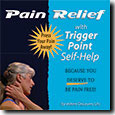
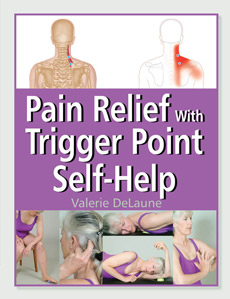
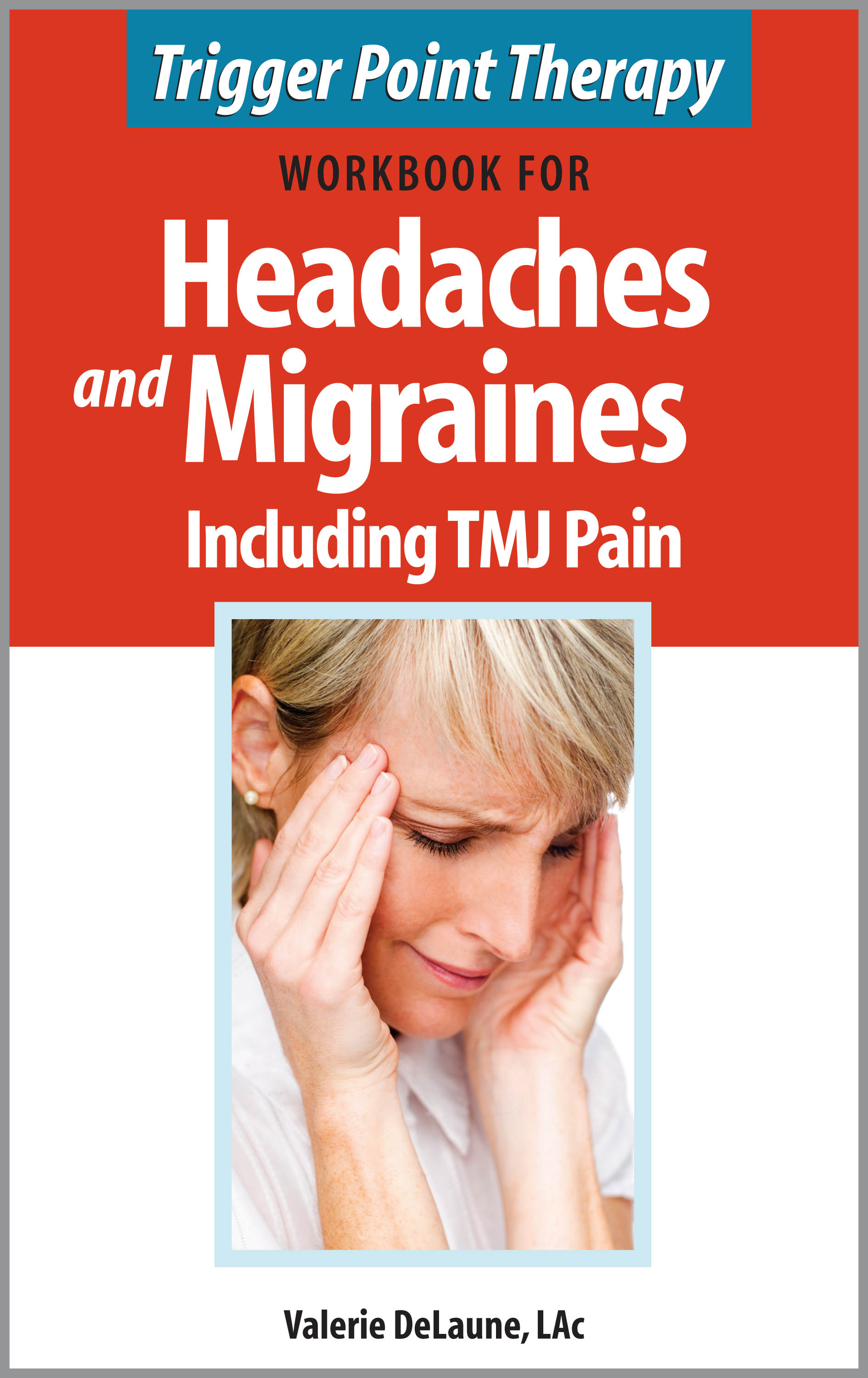
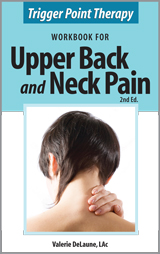
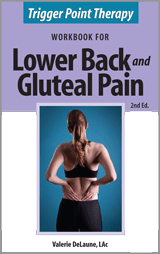
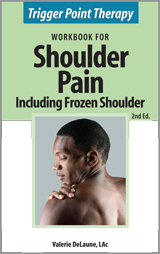
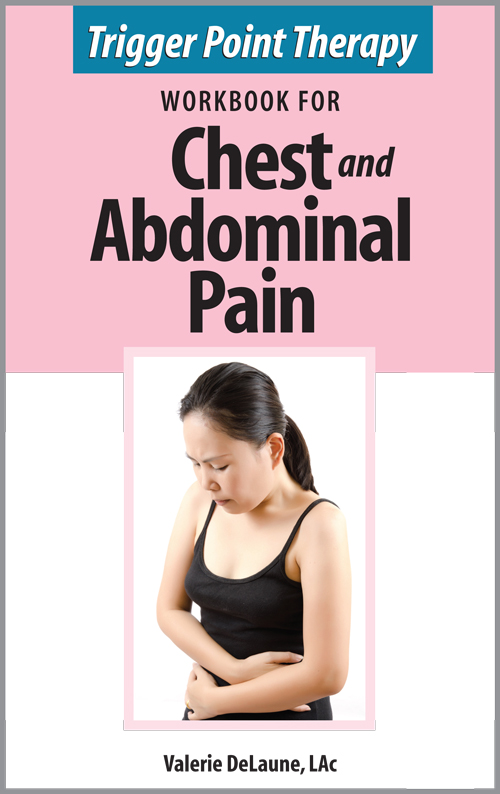
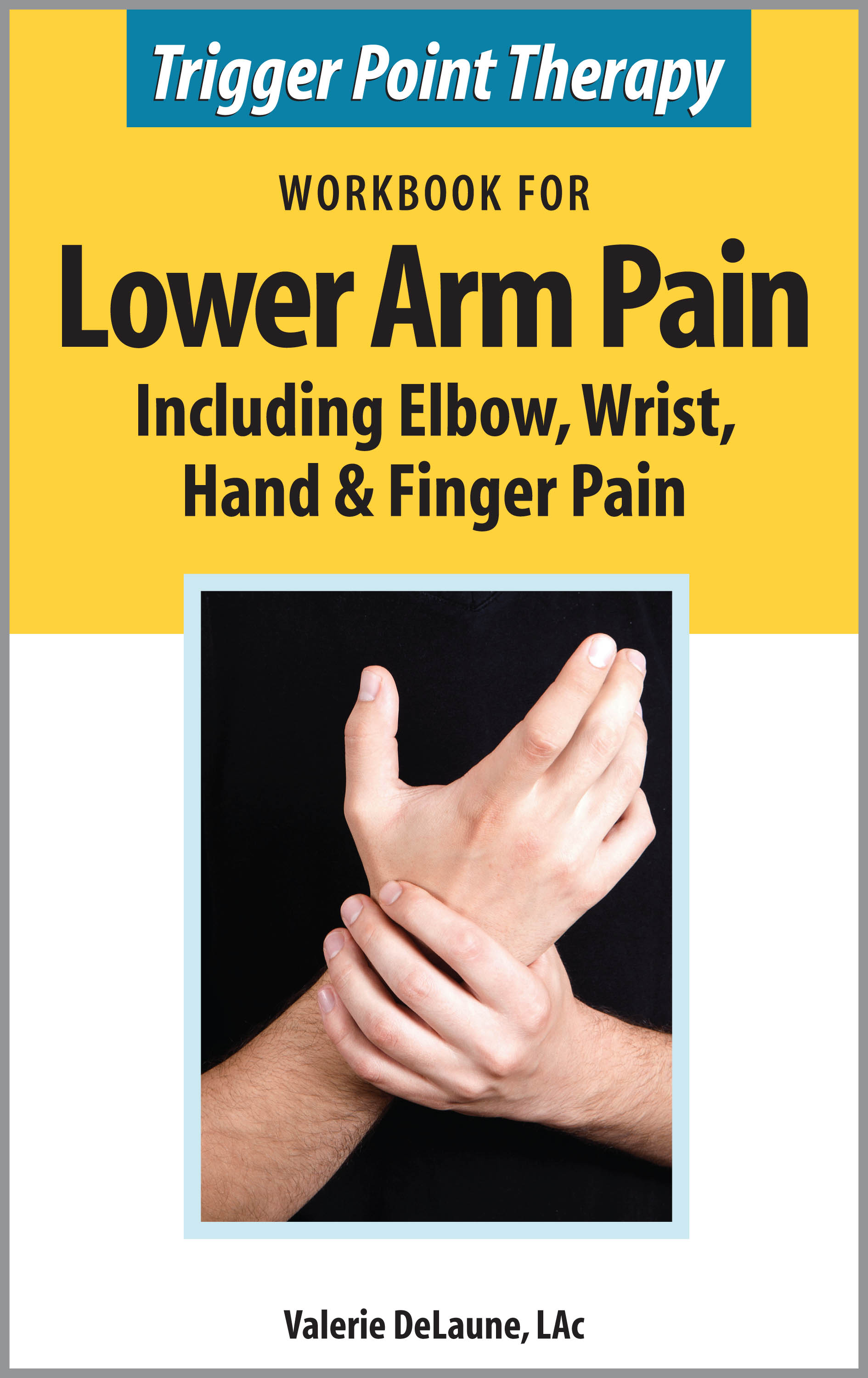
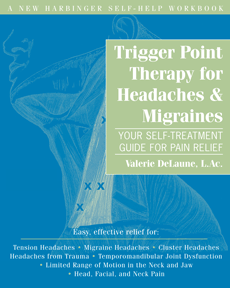
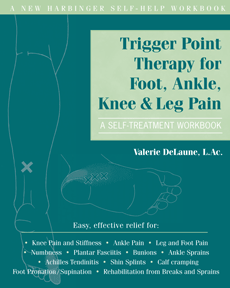
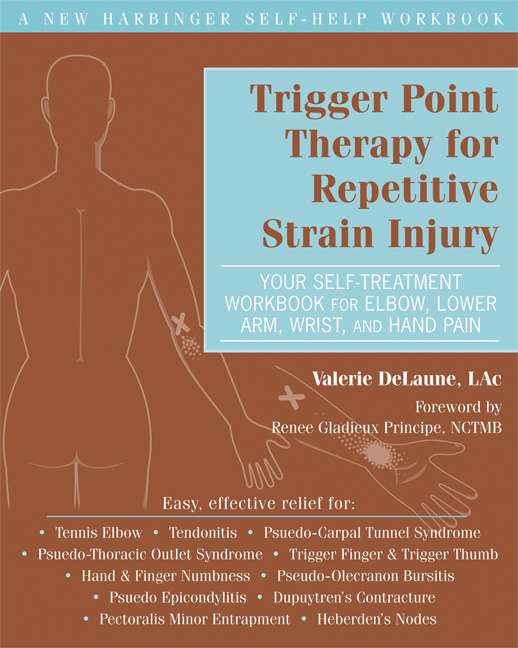
|